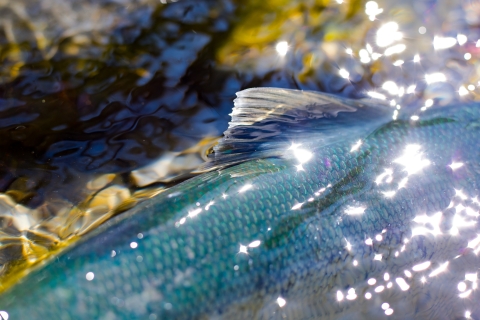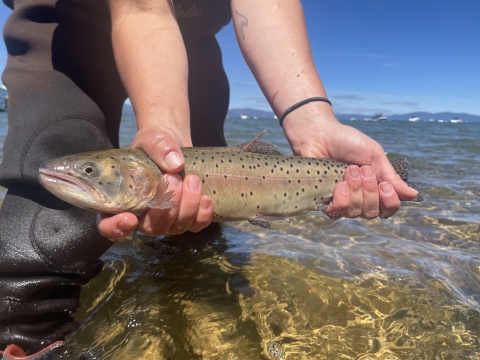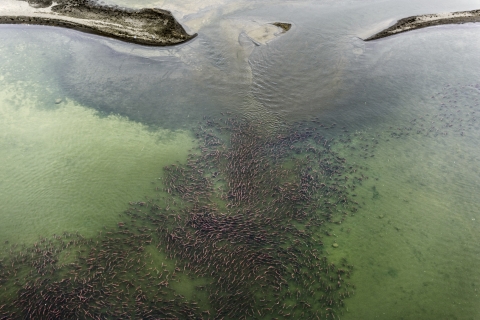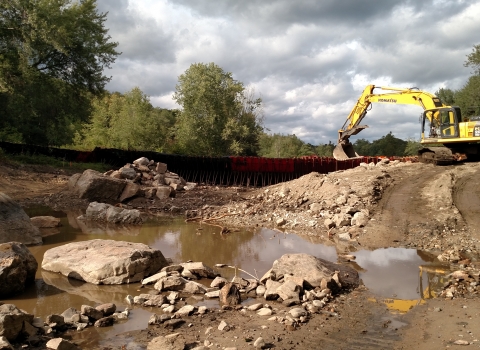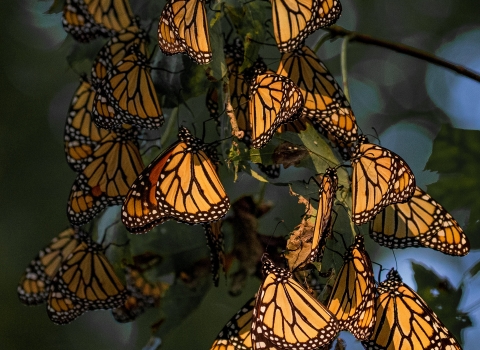Fish are easy to miss. From the shore, we only catch fleeting glimpses of silver scales or a darting shadow beneath the waves, but when we take a fish eye view beneath the surface, we find a complex, beautiful, and triumphant story of movement.
Across the world freshwater fish travel unseen through rivers and lakes to fulfill their lifecycles. They navigate using the currents, magnetic fields, even their sense of taste and smell. But whether they are travelling thousands of miles, like Atlantic salmon, or as little as a half a mile like some species of darter, freshwater fish rely on free-flowing connected rivers for their survival.
The rivers, streams, and coastal systems of North America once supported vast annual runs of fish such as Pacific salmon, American shad, blueback herring, Pacific lamprey and American eel. These species and many others, including some at-risk and listed species, depend on connected streams and high-quality habitat to survive.
We're celebrating World Fish Migration Day with a tour of some of our favorite fish migration stories!
World Fish Migration Day (WFMD) culminates every two years in a global celebration to create awareness about the importance of migratory fish and free-flowing rivers. On World Fish Migration Day, organizations from around the world coordinate their own event around the common theme of: CONNECTING FISH, RIVERS AND PEOPLE.
Reconnecting American Eel Migrations
Every American eel begins their life as a little egg floating in the warm waters of the Sargasso Sea. After hatching, young eels drift for thousands of miles on the ocean currents to the streams, rivers, and lakes that will be their home – a journey that can take years. The eels stay in the freshwater lakes and rivers of North and Central America until they reach maturity, between 10 to 25 years. Then, guided by instincts and senses we do not understand, the eels return to the Sargasso Sea to spawn. Every fall, in rivers from Greenland to Venezuela, the eels swim back downstream by the millions!
Returning home: The Legendary Lahontan Cutthroat Trout
Once facing almost certain extinction, the Lahontan cutthroat trout has experienced a truly incredible recovery. In 2006, Lahontan cutthroat trout were returned to Pyramid Lake for the first time in over 50 years thanks to the support of the Pyramid Lake Paiute Tribe and countless partners from federal and state agencies and universities. However, that milestone was not the end of their story. A century of changes along the Truckee River had altered water flow, and dams blocked the fish from reaching the spawning grounds they’d used for nearly 10,000 years. In September of 2020, the Bureau of Reclamation completed a fish screen over the century old Derby Dam giving trout access to 40 miles of river that had been inaccessible since 1905. Plans are in the works to ensure passage to even more habitat.
O'opu: Hawaiian Goby
On the other side of the world, on the islands of Hawai’i, a small goby makes a shorter, but no less spectacular migration. When we think of fish migrations we normally imagine species fighting their way upstream against the current for thousands of miles. But Hawaiian gobies are a different type of aquatic athlete. The have the uncanny ability to scale steep waterfalls by using their mouths and fins to suction themselves up rocks! The three types of native stream Hawaiian Gobies that possess this ability are the O'opu nopil, O’opu akupa, and the O’oppu naniha.
Pacific Salmon
Salmon may be the most well known of the migratory fish, and for good reason. Their heroic and dramatic migrations not only bogle the mind, they support entire ecosystems! In many coldwater ecosystems, salmon carcasses are a primary source of stream nutrients for arctic species. Salmon that spawn in in the Upper Yukon River have one the longest upstream spawning migration in the world with some fish migrating over 1,678 miles (2,700 km)!
The "King of Fish"
In the Atlantic Ocean the Atlantic salmon is known as the “King of Fish.” They were once found in most coastal rivers northeast of the Hudson in New York. Unfortunately, overfishing and dams that blocked their ability to spawn reduced their population size until the fisheries closed in 1948. Currently, the last wild populations of U.S. Atlantic salmon are found in a handful of rivers in Maine, but our National Fish Passage program and Craig Brook National Fish Hatchery are working with partners to ensure these fish continue to make their journey up stream.
Why help fish migrate?
Fish are an important part of our natural heritage. They also are an important link in the food web, consuming vegetation or smaller animals and providing food for wildlife. When they die, their carcasses can provide nutrients for plants. Fish and free-flowing rivers are important to people too, for recreational opportunities like fishing, boating, and wildlife viewing. Unfortunately, over six million barriers, like obsolete dams and poorly designed road culverts, can keep fish, and other aquatic species from moving freely to feed, migrate, and reproduce. These fish passage fish passage
Fish passage is the ability of fish or other aquatic species to move freely throughout their life to find food, reproduce, and complete their natural migration cycles. Millions of barriers to fish passage across the country are fragmenting habitat and leading to species declines. The U.S. Fish and Wildlife Service's National Fish Passage Program is working to reconnect watersheds to benefit both wildlife and people.
Learn more about fish passage barriers not only fragment aquatic habitats, they are also often more susceptible to impacts from climate change climate change
Climate change includes both global warming driven by human-induced emissions of greenhouse gases and the resulting large-scale shifts in weather patterns. Though there have been previous periods of climatic change, since the mid-20th century humans have had an unprecedented impact on Earth's climate system and caused change on a global scale.
Learn more about climate change . Since 1999, the U.S. Fish and Wildlife Service National Fish Passage Program has removed or bypassed more than 3,400 barriers to fish migration, reopened access to more than 61,000 miles of upstream habitat for fish and other wildlife.
Help support migratory fish!
You can help by spreading the word about fish migration and the work of the National Fish Passage Program! The National Fish Passage Program provides financial and technical assistance to support projects that improve community infrastructure resilience, rebuild fish populations, improve recreational and commercial fisheries, and restore the beauty of free-flowing waters. Project proposals may be initiated by any individual, organization, government, or agency, in cooperation with their local Fish and Wildlife Conservation Office. Contact a Fish Passage Coordinator in your area or contact your local Fish and Wildlife Conservation Office to discuss the project and learn more about the technical and financial assistance that is available. By working together, we can help to restore healthy fisheries and reverse the declines in migratory freshwater fish across America. CONTACT A FISH PASSAGE COORDINATOR IN YOUR AREA TO GET STARTED.
Join or host World Fish Migration Day Event in your city! From a glass eel release on the Hudson River, to fish passage walks in downtown Richmond, hundreds of World Fish Migration Day events are taking place across the globe. You can find an event to attend near you or host an event on your refuge or hatchery. Find and event with the WFMD registry.


